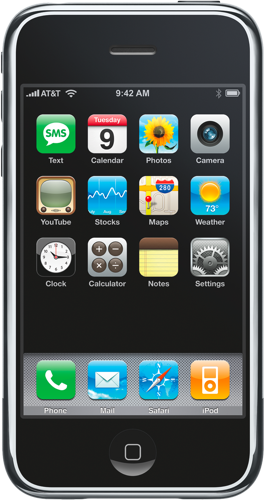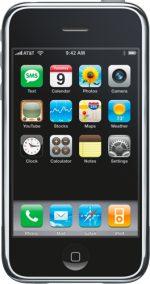
apple iphone 2 image
The iPhone (colloquially known as the iPhone 2G after 2008) is the first smartphone designed and marketed by Apple Inc. After years of rumors and speculation, it was officially announced on January 9, 2007, and was later released in the United States on June 29, 2007. It featured quad-band GSM cellular connectivity with GPRS and EDGE support for data transfer.
Development of the iPhone dated back to 2005, when former Apple CEO Steve Jobs conceived the idea of a device that users could directly interact with the display interface. The design was expanded upon over the next 2 years in complete secrecy, before being announced in Q1 2007.
Although several aspects of the iPhone are considered obsolete by current standards, the device is seen as an archetype of current cell phones, ditching physical hardware buttons and stylus in favor of a touch-based user interface. Its successor, the iPhone 3G, was announced in June of 2008.
Table of Contents
History
In 2005, Apple CEO Steve Jobs conceived an idea of using a multi-touch touchscreen to interact with a computer in a way in which he could directly type onto the display. He decided that it needed to have a triple layered touch screen, a very new and advanced technology at the time. This helped out with removing the physical keyboard and mouse, the same as a tablet computer. Jobs recruited a group of Apple engineers to investigate the idea as a side project. When Jobs reviewed the prototype and its user interface, he conceived a second idea of implementing the technology onto a mobile phone. The whole effort was called Project Purple 2 and began in 2005.
Apple created the device during a secretive and unprecedented collaboration with AT&T, formerly Cingular Wireless. The development cost of the collaboration was estimated to have been $150 million over a thirty-month period. Apple rejected the “design by committee” approach that had yielded the Motorola ROKR E1, a largely unsuccessful collaboration with Motorola. Instead, Cingular Wireless gave Apple the liberty to develop the iPhone’s hardware and software in-house.
The original iPhone was introduced by Steve Jobs on January 9, 2007 in a keynote address at the Macworld Conference & Expo held in Moscone West in San Francisco, California. In his address, Jobs said, “This is a day, that I have been looking forward to for two and a half years”, and that “today, Apple is going to reinvent the phone.” Jobs introduced the iPhone as a combination of three devices: a “widescreen iPod with touch controls”; a “revolutionary mobile phone”; and a “breakthrough Internet communicator”.
Six weeks before the iPhone was to be released, the plastic screen was replaced with a glass one, after Jobs was upset that the screen of the prototype he was carrying in his pocket had been scratched by his keys. The quick switch led to a bidding process for a manufacturing contractor that was won by Foxconn, which had just opened up a new wing of its Shenzhen factory complex specifically for this bid.
In February 2007, LG Electronics accused Apple of “copying” their LG Prada phone, which was introduced around the same time as iPhone.
Release
The iPhone was released in the United States on June 29, 2007 at the price of $499 for the 4 GB model and $599 for the 8 GB model, both requiring a 2-year contract. Thousands of people were reported to have waited outside Apple and AT&T retail stores days before the device’s launch; many stores reported stock shortages within an hour of availability. To avoid repeating the problems of the PlayStation 3 launch, which caused burglaries and even a shooting, off-duty police officers were hired to guard stores overnight.
Software
During release, the iPhone was marketed as running “OS X”. The name of the operating system was revealed as iPhone OS with the release of the iPhone SDK. The original iPhone supported three major versions of the operating system before it was discontinued: iPhone OS 1, 2, and 3. However, the full iPhone OS 3 feature set was not supported, and the last update the original iPhone received was iPhone OS 3.1.3
Software history
The original operating system for the original iPhone was iPhone OS 1, marketed as OS X, and included Visual Voicemail, multi-touch gestures, HTML email, Safari web browser, threaded text messaging, and YouTube. However, many features like MMS, apps, and copy and paste were not supported at release, leading hackers jailbreaking their phones to add these features. Official software updates slowly added these features.
iPhone OS 2 was released on July 11, 2008, at the same time as the release of the iPhone 3G, and introduced third-party applications, Microsoft Exchange support, push e-mail,[34] and other enhancements.
iPhone OS 3 was released on June 17, 2009, and introduced copy and paste functionality, Spotlight search for the home screen, and new features for the YouTube app. iPhone OS 3 was available for the original iPhone as well as the iPhone 3G. However, not all features of iPhone OS 3 were supported on the original iPhone.
iPhone OS 3.1.3 was the last version of iPhone OS (now iOS) to be released for the original iPhone.
iPhone 2G
This is the very first iPhone. It is sometimes referred to as the “iPhone 2G” due to its lack of support for 3G networks.
- Battery Specs:
- Current: 1400 mA
- Power: 5.18 Wh
- Voltage: 3.7 V
- Bluetooth 2.0 EDR
- Camera Specs:
- Rear: 1.9 megapixels[1]
- Cellular Radio: Up to EDGE (2.5G)
- Colors: Aluminum (Gray)
- CPU Specs:
- Core Design: ARM1176 x 1
- CPU: S5L8900
- CPU Speed: 400 MHz (412 MHz as of iPhone OS 1.1.2)
- Instruction Set: ARMv6
- Firmware:
- Initial firmware: 1.0 (1A543a)
- Latest firmware: 3.1.3 (7E18)
- Internal Name: iPhone1,1
- RAM: 128 MB
- Storage: 4/8/16 GB
- Wi-Fi: 802.11b/g






More Stories
Don’t Buy: 11 Reasons Not to Buy iPhone 15 Pro and Pro Max
Which 3g iPhone 5g octobersandlereuters
Which ee 3g 5g iphone you can buy in UK – 3G, 5G (Guide)